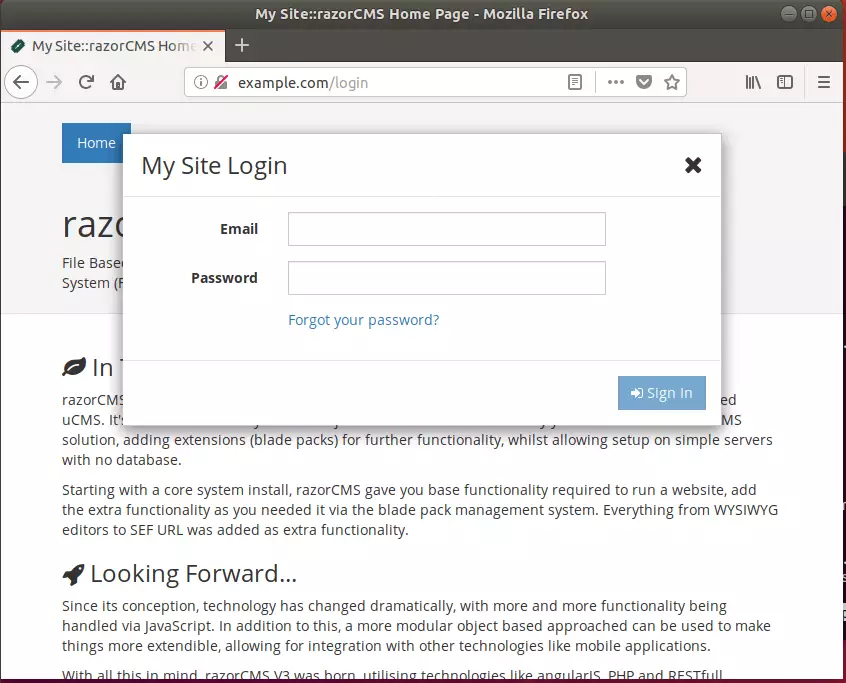This article explains how to install RazorCMS on Ubuntu Linux with Nginx support.
RazorCMS is a flat-file CMS (Content Management System) that allows you to create websites without needing a separate database and prioritizes simplicity and speed.
Setting up RazorCMS with Nginx on Ubuntu allows you to create and manage websites using a fast and simple flat-file CMS. With Nginx, you have a reliable and popular web server that can handle high traffic and ensure your website loads quickly.
Additionally, RazorCMS does not require a separate database, making it a lightweight and efficient option for web development. This tutorial provides step-by-step instructions on installing and configuring RazorCMS with Nginx on Ubuntu, making it easier for students and developers to create websites with this CMS.
For more about RazorCMS, please check its homepage.
Install Nginx HTTP Server on Ubuntu
Nginx HTTP Server is the most popular web server in use. Install it since RazorCMS needs it.
To install Nginx HTTP on the Ubuntu server, run the commands below.
sudo apt update sudo apt install nginx
After installing Nginx, the commands below can be used to stop, start, and enable the Nginx service to always start up with the server boots.
sudo systemctl stop nginx.service sudo systemctl start nginx.service sudo systemctl enable nginx.service
To test the Nginx setup, open your browser and browse to the server hostname or IP address. You should see the Nginx default test page, as shown below. When you see that, then Nginx is working as expected.
http://localhost

Install PHP 7.2 and Related Modules
PHP 7.2 may not be available in Ubuntu default repositories for some systems. So, you will have to get it from third-party repositories if you need it.
Run the commands below to add the below third party repository to upgrade to PHP 7.2
sudo apt-get install software-properties-common sudo add-apt-repository ppa:ondrej/php
Then update and upgrade to PHP 7.2
sudo apt update
Next, run the commands below to install PHP 7.2 and related modules.
sudo apt install php7.2-fpm php7.2-common php7.2-mbstring php7.2-xmlrpc php7.2-sqlite3 php7.2-soap php7.2-gd php7.2-xml php7.2-cli php7.2-curl php7.2-zip
After installing PHP 7.2, run the commands below to open Nginx’s PHP default config file.
sudo nano /etc/php/7.2/fpm/php.ini
Then, save the changes on the following lines below in the file. The value below is an excellent setting to apply in your environment.
file_uploads = On allow_url_fopen = On memory_limit = 256M cgi.fix_pathinfo = 0 upload_max_filesize = 100M max_execution_time = 360 date.timezone = America/Chicago
After making the change above, please save the file and close it.
After installing PHP and related modules, you must restart Nginx to reload PHP configurations.
To restart Nginx, run the commands below
sudo systemctl restart nginx.service
Download RazorCMS Latest Release
Next, visit the RazorCMS site and download the latest package. Or run the commands below to download RazorCMS packages from GitHub.
After downloading, run the commands below to extract the downloaded file and move it into a new RazorCMS root directory. After that, change into the RazorCMS root directory to install the PHP-required packages.
cd /tmp wget https://github.com/smiffy6969/razorCMS/archive/3.4.5.zip unzip 3.4.5.zip sudo mv razorCMS-3.4.5/ /var/www/html/razorcms
Then, run the commands below to set the correct permissions for RazorCMS to function correctly.
sudo chown -R www-data:www-data /var/www/html/razorcms/ sudo chmod -R 755 /var/www/html/razorcms/
Configure Nginx RazorCMS Site
Finally, configure the Nginx configuration file for RazorCMS. This file will control how users access RazorCMS content. Run the commands below to create a new configuration file called razor cms.
sudo nano /etc/nginx/sites-available/razorcms
Then copy and paste the content below into the file and save it. Replace the highlighted line with your domain name and directory root location.
server {
listen 80;
listen [::]:80;
root /var/www/html/razorcms;
index index.php index.html index.htm;
server_name example.com www.example.com;
client_max_body_size 100M;
location / {
try_files $uri $uri/ /index.php?$query_string;
}
location ~ \.php$ {
include snippets/fastcgi-php.conf;
fastcgi_pass unix:/var/run/php/php7.2-fpm.sock;
fastcgi_param SCRIPT_FILENAME $document_root$fastcgi_script_name;
include fastcgi_params;
}
}
Save the file and exit.
After configuring the VirtualHost above, please enable it by running the commands below.
Enable the RazorCMS Site
After configuring the VirtualHost above, please enable it by running the commands below, then restart the Nginx server.
sudo ln -s /etc/nginx/sites-available/razorcms /etc/nginx/sites-enabled/
Restart Nginx
sudo systemctl restart nginx.service
Next, open your browser and browse the server hostname or IP address. You should see the RazorCMS page. Enter your blog info and complete the setup.
http://example.com/login
Login with the following credentials:
- Login in with the following default credentials:
- Username/email: razorcms@razorcms.co.uk
- Password: password

Enjoy!
razorCMS began as a database-less flat file content management system, forked from an LCMS project. Its structure allowed you to have just the amount of functionality needed in a flat file CMS solution, adding extensions (blade packs) for additional functionality while allowing setup on simple servers with no database.
You may also like the post below:

Leave a Reply Cancel reply